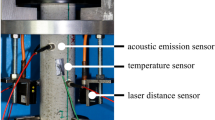Abstract
Length changes of mortar-porcelain and mortar-quarry tile composites (typically 10×3×8 mm) have been examined in the temperature range −10 to +50°C. The effect of heating rate (1 and 4°C/min.), dimensions of specimens, volume ratio of components and location of the measuring point with reference to the interface were evaluated. Length changes of the interfacial zone significantly deviated from the values predicted by assumption of elastic behaviour. Good agreement between measured and calculated values was obtained, however, outside the interfacial zone extending 5 mm into the mortar and 3.5 mm into the tile component.
Résumé
On a examiné les variations de longueur de carrelages mortier-porcelaine et mortier-carreau céramique (10×3×8 mm en moyenne) à des températures variant de −10 à 50°C. On a relevé les effets de la vitesse de chauffage (1 et 4°C/mn), des dimensions des échantillons, du rapport entre les volumes des constituants, et de l'emplacement du point de mesure par rapport à l'interface.
Les conclusions ont été les suivantes:
-
1.
Les contraintes thermiques dans la zone de l'interface des carrelages mortier-porcelaine et mortier-carreau céramique ont révélé un comportement visco-élastique.
-
2.
Le mortier, la porcelaine et la pierre juxtaposés se comportent élastiquement en dehors de la zone de l'interface.
-
3.
L'effet restrictif des éléments sur les contraintes thermiques duex aux variations de température a pu être observé jusqu'à 3,5 mm de l'interface du côté de la porcelaine et jusqu'à 5,0 mm du côté du mortier.
-
4.
Le rapport entre les volumes des constituants modifie la déformation de l'ensemble, notamment dans la zone de l'interface.
-
5.
La résine époxyde, qui a servi de liant au cours de l'expérience, ne réduit pas la contrainte interfaciale.
Similar content being viewed by others
References
Hsu T. T. C., Slate F. O., Sturman G. M., Winter G. —Microcracking of plain concrete and the shape of the stress-strain curve, Journal of the American Concrete Institute, Proceedings, Vol. 60, 1963, p. 209.
Pinchin D. J., Tabor D.—Inelastic behaviour in steel wire pull-out from portland cement mortar, Journal of Materials Science, Vol. 13, 1978, p. 1261.
Swamy R. N., Bandyopadhyay A. K., Stavrides H.—The ring method of measuring restrained shrinkage in mortar and concrete, Cement and Concrete Aggr., Vol. 1, 1979, p. 13.
Ostle B., Mensing R. W.—Statistics in research, 3rd ed., Iowa State University Press, Ames, 1975.
Timoshenko S. P., Goodier J. N.—Theory of elasticity, 3rd ed., McGraw-Hill Book Company, 1970, p. 433.
Ibid. Timoshenko S. P., Goodier J. N.—Theory of elasticity, 3rd ed., McGraw-Hill Book Company, 1970, In Ref. [5], p. 118.
Author information
Authors and Affiliations
Rights and permissions
About this article
Cite this article
Yoshikawa, K., Litvan, G.G. Thermal stresses in mortar-tile systems. Mat. Constr. 17, 351–357 (1984). https://doi.org/10.1007/BF02478707
Issue Date:
DOI: https://doi.org/10.1007/BF02478707




